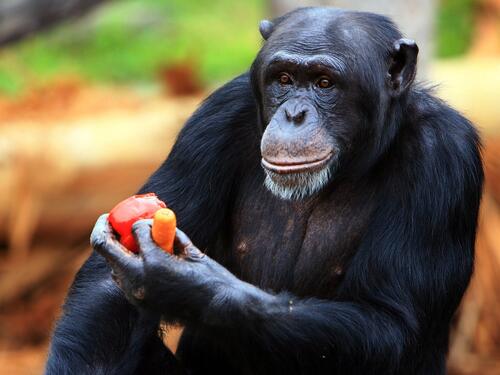Animals have evolved a variety of sensory abilities in nature to help them adapt to the environment, find food, and escape predation In addition to the five common senses of humans (sight, hearing, smell, taste and touch), some animals have developed special perceptions that are beyond the scope of human capabilities. Here are the main sensory abilities possessed by animals and their unique evolutionary characteristics:
1. Vision
Vision is one of the main perception methods of many animals, but the visual abilities of different animals vary significantly :
a. Ultraviolet vision
Birds, Insects Eyes (such as bees) and some fish can see ultraviolet light, which helps them perceive colors and patterns that humans cannot see when searching for food and mates. Bees use ultraviolet light to see special markings on flowers that help them find nectar.
b. Infrared Vision
c. Multi-directional Vision
2. Hearing
Animals have different hearing ranges, and some animals can sense frequencies that humans cannot hear, such as ultrasound and infrasound:
a. Ultrasound Perception
Bats, dolphins, etc. emit ultrasonic waves and receive echoes through echolocation, which helps them hunt and navigate in the dark or underwater.
Rodents (such as mice) and dogs can also hear high-frequency ultrasonic waves, especially when mating or avoiding predators.
b. Infrasound Perception
Elephants, whales, etc. can perceive low-frequency infrasound waves, which can travel long distances and help them communicate and navigate in a large environment.
Smell is a key sense used by animals to identify food, predators, peers, and mates. Some animals have a far more acute sense of smell than humans:
a. Hounds
b. Sharks
4. Taste
Although many animals rely on smell to judge food, taste is also well developed in some animals:
b. Fish
Some fish, such as carp, have taste receptors located throughout their skin, helping them better sense food sources in the water.
5. Sense of touch
The sense of touch is extremely sensitive in some animals, helping them sense changes in their surroundings:
a. Whiskers of cats
b. Spider hairs
6. Magnetic induction
Some animals can sense the Earth's magnetic field for navigation and positioning:
a. Birds
b. Sea turtles
7. Electro-sensing
Some aquatic animals can sense the electrical signals emitted by other organisms, helping them locate prey or companions in turbid water:
a. Electric eel
b. Sharks
8. Infrared perception
Some animals can sense infrared heat emitted by the environment, and this ability is essential for hunting and survival at night:
a. Snakes
Such as rattlesnakes, pythonsetc., using special receptors to sense the heat emitted by prey, helping them to find and catch prey in the dark.
9. Echolocation
Echolocation is a special ability of some animals to perceive the surrounding environment by emitting sound waves and receiving reflected sound waves:
b. dolphins.html">Dolphins
10. Vibration perception
Some animals sense danger or the approach of prey by sensing vibrations:
a. Spiders
b. Elephants-Are-Endangered.html">elephants
Animals have far more diverse and complex perceptual abilities than humans. Through evolution, different species of animals have developed highly adaptable special abilities in vision, hearing, smell, touch, electroreception, and magnetic induction, which help them survive, reproduce, and maintain the continuation of their populations in their respective environments.
Can any animal see microwaves?
The world we live in is full of electromagnetic waves of different wavelengths, including visible light, ultraviolet light, infrared light, microwaves, etc. Humans can only see electromagnetic waves of visible light, while microwaves are invisible to the human eye. So, are there animals that can see microwaves?
1. What are microwaves?
Before we understand whether animals can see microwaves, let's first take a look at what microwaves are. Microwaves are a type of electromagnetic wave with a longer wavelength, ranging from 1 mm to 1 m, between infrared and radio waves. The most common application of microwaves is the microwave oven, which uses microwaves to heat food.
Microwaves have a wavelength that is too long to stimulate the visual receptors (photoreceptors) in the eyes of humans and most animals, so humans and most known animals cannot "see" microwaves.
2. What electromagnetic waves can animals see?
While no animals are known to see microwaves directly, some animals can sense or "see" other wavelengths of electromagnetic waves that humans cannot. These bands include ultraviolet and infrared, which, while not exactly the same as microwaves, provide some clues to how animals perceive electromagnetic waves.
a. Ultraviolet Perception
Some insects, birds, and amphibians can sense ultraviolet light, which has a shorter wavelength than visible light. For example:
Bees: Bees can see ultraviolet light, which helps them better find nectar in flowers.
Birds: Many birds can see not only visible light, but also ultraviolet light, which helps them see different color patterns when foraging and choosing mates.
b. Infrared perception
Some animals can sense infrared, which is a type of electromagnetic wave with a longer wavelength than visible light. Infrared perception is mainly related to temperature changes, not visual perception. For example:
Snakes: such as vipers and rattlesnakes, can sense the infrared heat given off by their prey's bodies. This perception helps them catch prey in the dark.
Vampire bats: Vampire bats can determine the location of blood vessels by sensing the infrared heat on the surface of their prey.
3. Why can't animals see microwaves?
Microwaves have a longer wavelength and lower energy, which is not enough to stimulate the photoreceptor cells in animals' eyes. Animal eyes are designed to adapt to specific wavelengths of light. Microwaves do not produce direct vision or heat sensations like ultraviolet or infrared light.
In addition, microwave wavelengths are so large that the receptors in animals cannot capture the energy fluctuations of these wavelengths and will not produce any visible effect.
4. How do animals sense other signals in their environment?
Although animals cannot see microwaves, they have many other ways to sense signals in their environment, including sound, temperature, smell, and electromagnetic fields:
Electroception: Some aquatic animals, such as sharks and electric eels, can sense tiny changes in electric fields in their prey through electroreceptors.
Magnetoception: Some birds and turtles use the Earth's magnetic field to navigate, especially during migration.
5. Possible changes brought about by future scientific developments
As science and technology develop, future research may reveal more about how animals sense electromagnetic waves. Currently, no known animal can directly sense microwaves, but if more complex sensing systems are found in nature, it may change our understanding of animal perception.
Currently, no known animal can see microwaves. Microwaves are a type of electromagnetic wave with a longer wavelength and lower energy, which is beyond the range of perception of the photoreceptors in the eyes of animals. However, many animals can sense other electromagnetic waves that are invisible to humans, such as ultraviolet and infrared, which helps them play an important role in foraging, reproduction and survival.
If future scientific research reveals more complex sensory systems, perhaps we will find that animals' ability to perceive the environment is far beyond our current cognition, but for now, microwaves are still a band that cannot be detected by human and animal visual systems.
Which animals can hear infrasound and ultrasound?
In nature, animals have different hearing abilities, and some animals can hear sound frequencies that humans cannot perceive, including infrasound and ultrasound. This special hearing ability helps them gain advantages in foraging, escaping predators, and communicating.
1. What are infrasound and ultrasound?
Infrasound: Sound with a frequency below 20 Hz, which is below the human hearing range. Infrasound has a long wavelength, can travel a long distance, and can penetrate obstacles.
Ultrasound: Sound with a frequency above 20,000 Hz, which is above the human hearing range. Ultrasound has a short wavelength, can accurately locate objects, and is widely used for animal navigation and hunting.
2. Which animals can hear infrasound?
Animals that can hear infrasound usually live in vast environments, such as grasslands, oceans, or are animals that need to communicate over long distances.
a. Elephants
African elephants and Asian elephants are the epitome of infrasound hearing. They are able to communicate over long distances using low-frequency sounds that can travel for kilometers, helping elephant groups stay connected, especially when foraging, breeding, and defending against predators. The low-frequency calls of elephants can even be transmitted through the ground and sensed by other elephants.
b. Whales
Some whales, especially blue whales and humpback whales, are able to communicate underwater over long distances using infrasound. This low-frequency sound can penetrate the sea water and help whales find companions in the sea or communicate reproductive behavior.
c. Giraffe
d. Crocodile
3. Which animals can hear ultrasound?
Many animals rely on ultrasound for navigation, hunting, or communication, especially those that live at night or rely on high-precision positioning.
a. Bats
Bats are a typical example of ultrasound positioning. Bats use echolocation to emit ultrasound and capture the reflected sound waves to determine the location, size, and flight speed of prey. This makes it easy for them to hunt insects at night or in dark environments.
Dolphins also use echolocation to emit ultrasound for navigation and hunting. Dolphins' ultrasonic positioning abilities are particularly useful in turbid waters, where they can sense their surroundings by emitting high-frequency sound waves and receiving the echoes, and can even "see" prey hidden in the sand.
c. Canines
Dogs have a wider hearing range than humans, and can hear high-frequency sounds, including certain ultrasonic sounds. This is why dog whistles can get their attention, while humans can't hear such sounds.
d. Cats
f. Insects
Some insects, such as moths, can sense the ultrasonic sounds emitted by bats and use them to escape predation. Their auditory systems can detect the echolocation signals of bats, allowing them to quickly escape.
4. Application of infrasound and ultrasound by animals
a. Application of infrasound
Long-distance communication: Elephants and whales use infrasound to communicate over long distances, especially across vast grasslands or oceans.
Transmitting threat signals: Elephants and crocodiles use infrasound to send threat or defense signals to protect territory or attract mates.
b. Application of Ultrasound
Echolocation: Bats and dolphins are experts in echolocation, and can accurately find prey in complex or dark environments through ultrasound.
Predation and Escape: Cats and dogs enhance their hunting ability by sensing ultrasound, while some insects escape predators by sensing ultrasound.
Conclusion
Animals in nature have evolved a series of sophisticated hearing systems to help them gain advantages in survival and reproduction. Elephants and whales use infrasound to communicate over long distances, and bats and dolphins use ultrasound to achieve precise echolocation. While humans have a limited range of hearing, by observing and studying the special abilities of these animals, we can better understand and apply the power of sound.
animal tags: Bird Cat Dolphin Elephant Spider
We created this article in conjunction with AI technology, then made sure it was fact-checked and edited by a Animals Top editor.








